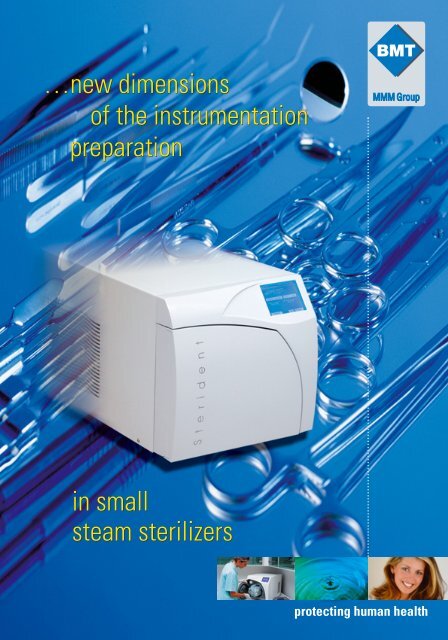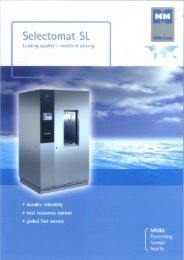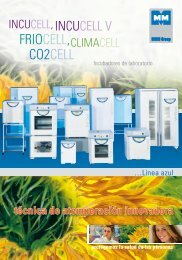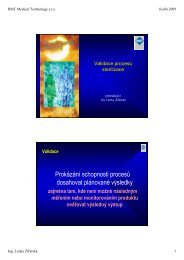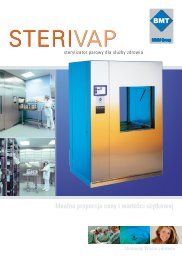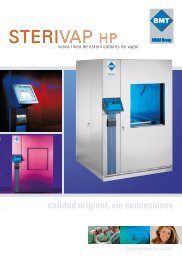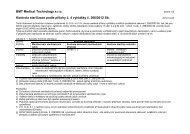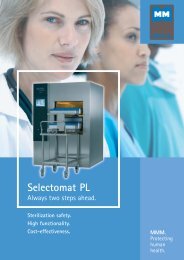Small steam sterilizers - BMT Medical Technology sro
Small steam sterilizers - BMT Medical Technology sro
Small steam sterilizers - BMT Medical Technology sro
Create successful ePaper yourself
Turn your PDF publications into a flip-book with our unique Google optimized e-Paper software.
…new dimensions<br />
of the instrumentation<br />
preparation<br />
in small<br />
<strong>steam</strong> <strong>sterilizers</strong><br />
protecting human health
Which sterilizer shall I choose<br />
for my medical workplace?<br />
Take advantage of some proven advice<br />
and information from us, <strong>BMT</strong> <strong>Medical</strong> <strong>Technology</strong> s.r.o.,<br />
a reputable manufacturer of medicine technology.<br />
What do we recommend?<br />
• The EU standard EN 13060 for small <strong>steam</strong> <strong>sterilizers</strong><br />
is already valid, do buy your devices without compromises!<br />
• Pay attention to national regulations that may specify how to perform the<br />
sterilization at your workplace.<br />
• Secure also the documentation of sterilization cycles.<br />
What is to be verified?<br />
4. What are the risks of hot air<br />
sterilization?<br />
a) Hot air sterilization is not able to inactivacte prions at<br />
the temperatures of 160–180 °C. It is only possible at<br />
the temperature as high as 1 000°C. (Steam sterilization<br />
inactivates prions with the sterilization process of<br />
134 °C/18 min provided that there was an alkaline<br />
washing performed during the pre-sterilization<br />
treatment)<br />
b) It does not sterilize textiles, cellulose, paper, thermally<br />
sensitive materials and hollow items (Steam sterilization<br />
sterilizes everything except thermally sensitive materials<br />
below 121 °C).<br />
c) The high temperature of the hot air sterilization “makes<br />
the blades of instruments blunt”.<br />
d) Duration of the sterilization cycle is as much as three<br />
times so long as that of the <strong>steam</strong> sterilization. It saves<br />
neither time nor energy.<br />
e) There is usually an insoluble problem with the old<br />
technology how to keep the deviation of the actual<br />
temperature from the preset one within acceptable<br />
limits.<br />
5. What are the types of small <strong>steam</strong><br />
<strong>sterilizers</strong> or sterilization programs<br />
defined by the standard EN 13060?<br />
The standard EN 13060 does not define types of <strong>sterilizers</strong>,<br />
as they were specified in the former version of the draft<br />
standard. It defines unambiguously types of sterilization cycles<br />
according to the type of the material to be sterilized.<br />
Types of sterilization cycles:<br />
a) type B – is intended for sterilization of all materials and<br />
load types, especially with regard to the requirements to<br />
sterilize hollow items through fractioned vacuum<br />
b) type N – is intended only for sterilization of unwrapped<br />
solid items<br />
c) type S – is intended only for sterilization of items specified<br />
by the manufacturer<br />
The sterilization of hollow items without the necessity<br />
for the operator to investigate, which type of hollow and of<br />
wrapped material is to be sterilized, can be successful only<br />
with <strong>steam</strong> <strong>sterilizers</strong> having the type B sterilization cycles.<br />
In other cases, when using other cycle types (S and N), it is<br />
the healthcare provider’s responsibility to properly assess the<br />
content and type of a load.<br />
Pressure (kPa)<br />
6. What does the vacuum pump serve<br />
for?<br />
Vaccum pump is a device that is a part of the sterilizer<br />
and enables to remove the air from porous and hollow items<br />
so that the access of the sterilization medium (<strong>steam</strong>) to all<br />
parts of the load to be sterilized is ensured. The power of the<br />
vacuum pump is important in the phase of fractioned vacuum<br />
with the underpressure of –87 kPa for sterilization of all kinds<br />
of porous and hollow items. That is why there are different<br />
prices of the devices having the same appearance, nevertheless<br />
the vacuum pump of which is cheaper and less powerful.<br />
Therefore it is necessary to consult these aspects with<br />
the distributor before purchasing.<br />
7. What is fractioned vacuum?<br />
Fractioned vacuum consists of at least three consequent<br />
evacuations and is performed before the sterilization process<br />
itself so that the condition for sterilization of porous items is<br />
fulfilled. In the past and frequently in the recent time, an offer<br />
of the sterilization technology with only one vacuum stage<br />
can appear on the market. However, this technology is not<br />
appropriate for sterilization of hollow items.<br />
1. What does the European standard<br />
EN 13060 concern?<br />
The standard EN 13060 concerns small <strong>steam</strong> <strong>sterilizers</strong><br />
(SSS). It is valid in the EU states since 06/2004 and specifies,<br />
which technical parameters shall be fulfilled with the SSS<br />
products.<br />
It is applied on <strong>steam</strong> <strong>sterilizers</strong> having the chamber<br />
volume not larger than 60 litres and the chamber which is<br />
unable to accommodate the sterilization unit (dimensions of<br />
300 x 300 x 600 mm).<br />
2. Which regulations are to be met by<br />
a small <strong>steam</strong> sterilizer and how to<br />
verify it with the specific product?<br />
Before purchasing a device it is suitable to ask for the EC<br />
Declaration of Conformity where you can verify whether the<br />
product is in accordance with the European regulations. There<br />
has to be a reference to the EU Directive No. 93/42/EEC there.<br />
The product has to bear the CE mark together with the number<br />
of the the notified body that was engaged in the conformity<br />
assessment, e.g. CE 0123.<br />
A reputable manufacturer will give a list of applied<br />
harmonized standards and other regulations e.g. EN 13060,<br />
EN 554 etc.<br />
3. How to identify these facts with the<br />
product?<br />
a) The program equipment of the device includes, beside the<br />
test programs such as Vacuum test and Bowie & Dick test,<br />
also a test program for hollow items type A called Helix test.<br />
b) The software includes a type B sterilization program or a<br />
program for hollow loads.<br />
c) The devices are provided with a powerfull vacuun pump<br />
that can reach an underpressure of –87kPa during the<br />
evacuation (deaeration) and enables therefore to shorten<br />
the sterilization program Wrapped instruments 134°C/<br />
/10 min. to 134 °C/7 min and the program Unwrapped<br />
instruments to 134 °C/4 min.<br />
d) The product, its packing and Instructions for use shall<br />
bear the CE mark together with the number of the notified<br />
body that was engaged in the conformity assessment.<br />
e) By law, there must be a conformity mark with the number<br />
of the notified body e.g. CE 0123 placed on the product, e.g.<br />
next to the serial label. Some manufacturers present the<br />
conformity mark also in their hand-out.<br />
f) Verify, whether the circuits of drain and supply water are<br />
separated properly and whether the condensate is not<br />
used repeatedly.<br />
0<br />
–87 kPa<br />
Time<br />
(min)<br />
8. What about the documentation of<br />
the sterilization cycle?<br />
The quality system requires to document the courses of<br />
sterilization processes. The sterilization process documentation<br />
can be arranged in a modern way, so that all records can be<br />
identified unambiguously without danger of being affected<br />
by a human error. There are offers of communication interfaces<br />
RS 232 that enable the application of suitable software with<br />
the possibility to be connected to your computer directly at<br />
the workplace.<br />
Do buy without compromises!
New standard<br />
New requirements<br />
New generation of small <strong>steam</strong> <strong>sterilizers</strong><br />
STERIDENT (15 l) STERIMAT (20 l) STERIMATPLUS (25 l)<br />
• utilization especially at stomatological<br />
• wide range of utilization at medical<br />
workplaces<br />
workplaces<br />
workplaces<br />
• utilization especially at surgical<br />
<strong>Small</strong> <strong>steam</strong> <strong>sterilizers</strong> – STERIDENT, STERIMAT, STERIMATPLUS<br />
• meet, without exception, requirements of EU technical and legislative regulations, the conformity mark CE0123 is a guaranty that the products<br />
are in compliance with the EU legislative<br />
• offer a design with four patents that is protected by the industrial pattern (patented system of <strong>steam</strong> regulation and generation,<br />
patented system of unique hardware, patented system of door closing, patented compound function of pump)<br />
Ask for information about other products<br />
Hot-air sterilizer STERICELL 22, 55, 111, 222 and 404 l Steam sterilizer UNISTERI 70 l Steam sterilizer STERIVAP HP 140–1275 l<br />
<strong>BMT</strong> <strong>Medical</strong> <strong>Technology</strong> s.r.o., Cejl 50, CZ 656 60 BRNO<br />
Tel.: +420 545 537 111, fax: +420 545 211 750, e-mail: mail@bmt.cz, http://www.bmt.cz<br />
MPS_legislativa – 10/2008 – EN/9540<br />
© Photo & design T. Benda


